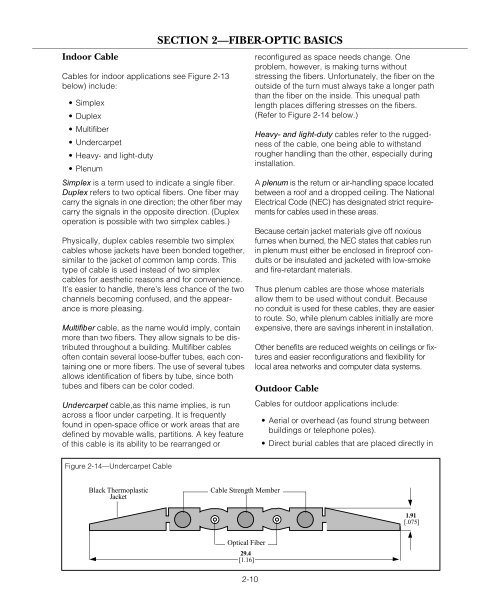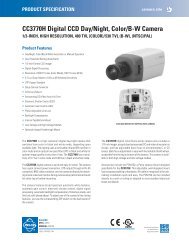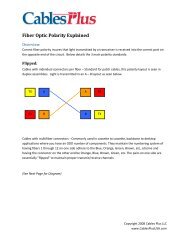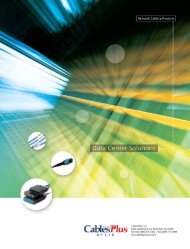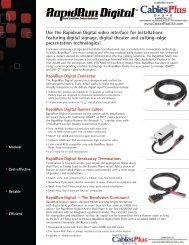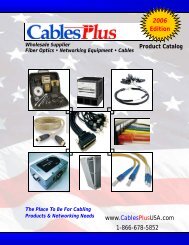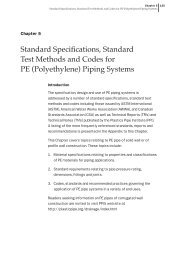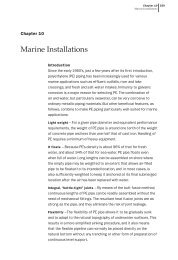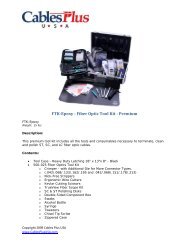Learning About Options in Fiber - Cables Plus USA
Learning About Options in Fiber - Cables Plus USA
Learning About Options in Fiber - Cables Plus USA
You also want an ePaper? Increase the reach of your titles
YUMPU automatically turns print PDFs into web optimized ePapers that Google loves.
Indoor Cable<br />
<strong>Cables</strong> for <strong>in</strong>door applications see Figure 2-13<br />
below) <strong>in</strong>clude:<br />
• Simplex<br />
• Duplex<br />
• Multifiber<br />
• Undercarpet<br />
• Heavy- and light-duty<br />
• Plenum<br />
Simplex is a term used to <strong>in</strong>dicate a s<strong>in</strong>gle fiber.<br />
Duplex refers to two optical fibers. One fiber may<br />
carry the signals <strong>in</strong> one direction; the other fiber may<br />
carry the signals <strong>in</strong> the opposite direction. (Duplex<br />
operation is possible with two simplex cables.)<br />
Physically, duplex cables resemble two simplex<br />
cables whose jackets have been bonded together,<br />
similar to the jacket of common lamp cords. This<br />
type of cable is used <strong>in</strong>stead of two simplex<br />
cables for aesthetic reasons and for convenience.<br />
It’s easier to handle, there’s less chance of the two<br />
channels becom<strong>in</strong>g confused, and the appearance<br />
is more pleas<strong>in</strong>g.<br />
Multifiber cable, as the name would imply, conta<strong>in</strong><br />
more than two fibers. They allow signals to be distributed<br />
throughout a build<strong>in</strong>g. Multifiber cables<br />
often conta<strong>in</strong> several loose-buffer tubes, each conta<strong>in</strong><strong>in</strong>g<br />
one or more fibers. The use of several tubes<br />
allows identification of fibers by tube, s<strong>in</strong>ce both<br />
tubes and fibers can be color coded.<br />
Undercarpet cable,as this name implies, is run<br />
across a floor under carpet<strong>in</strong>g. It is frequently<br />
found <strong>in</strong> open-space office or work areas that are<br />
def<strong>in</strong>ed by movable walls, partitions. A key feature<br />
of this cable is its ability to be rearranged or<br />
SECTION 2—FIBER-OPTIC BASICS<br />
reconfigured as space needs change. One<br />
problem, however, is mak<strong>in</strong>g turns without<br />
stress<strong>in</strong>g the fibers. Unfortunately, the fiber on the<br />
outside of the turn must always take a longer path<br />
than the fiber on the <strong>in</strong>side. This unequal path<br />
length places differ<strong>in</strong>g stresses on the fibers.<br />
(Refer to Figure 2-14 below.)<br />
Heavy- and light-duty cables refer to the ruggedness<br />
of the cable, one be<strong>in</strong>g able to withstand<br />
rougher handl<strong>in</strong>g than the other, especially dur<strong>in</strong>g<br />
<strong>in</strong>stallation.<br />
A plenum is the return or air-handl<strong>in</strong>g space located<br />
between a roof and a dropped ceil<strong>in</strong>g. The National<br />
Electrical Code (NEC) has designated strict requirements<br />
for cables used <strong>in</strong> these areas.<br />
Because certa<strong>in</strong> jacket materials give off noxious<br />
fumes when burned, the NEC states that cables run<br />
<strong>in</strong> plenum must either be enclosed <strong>in</strong> fireproof conduits<br />
or be <strong>in</strong>sulated and jacketed with low-smoke<br />
and fire-retardant materials.<br />
Thus plenum cables are those whose materials<br />
allow them to be used without conduit. Because<br />
no conduit is used for these cables, they are easier<br />
to route. So, while plenum cables <strong>in</strong>itially are more<br />
expensive, there are sav<strong>in</strong>gs <strong>in</strong>herent <strong>in</strong> <strong>in</strong>stallation.<br />
Other benefits are reduced weights on ceil<strong>in</strong>gs or fixtures<br />
and easier reconfigurations and flexibility for<br />
local area networks and computer data systems.<br />
Outdoor Cable<br />
<strong>Cables</strong> for outdoor applications <strong>in</strong>clude:<br />
• Aerial or overhead (as found strung between<br />
build<strong>in</strong>gs or telephone poles).<br />
• Direct burial cables that are placed directly <strong>in</strong><br />
Figure 2-14—Undercarpet Cable<br />
Black Thermoplastic<br />
Jacket<br />
Cable Strength Member<br />
1.91<br />
[.075]<br />
Optical <strong>Fiber</strong><br />
29.4<br />
[1.16]<br />
2-10


